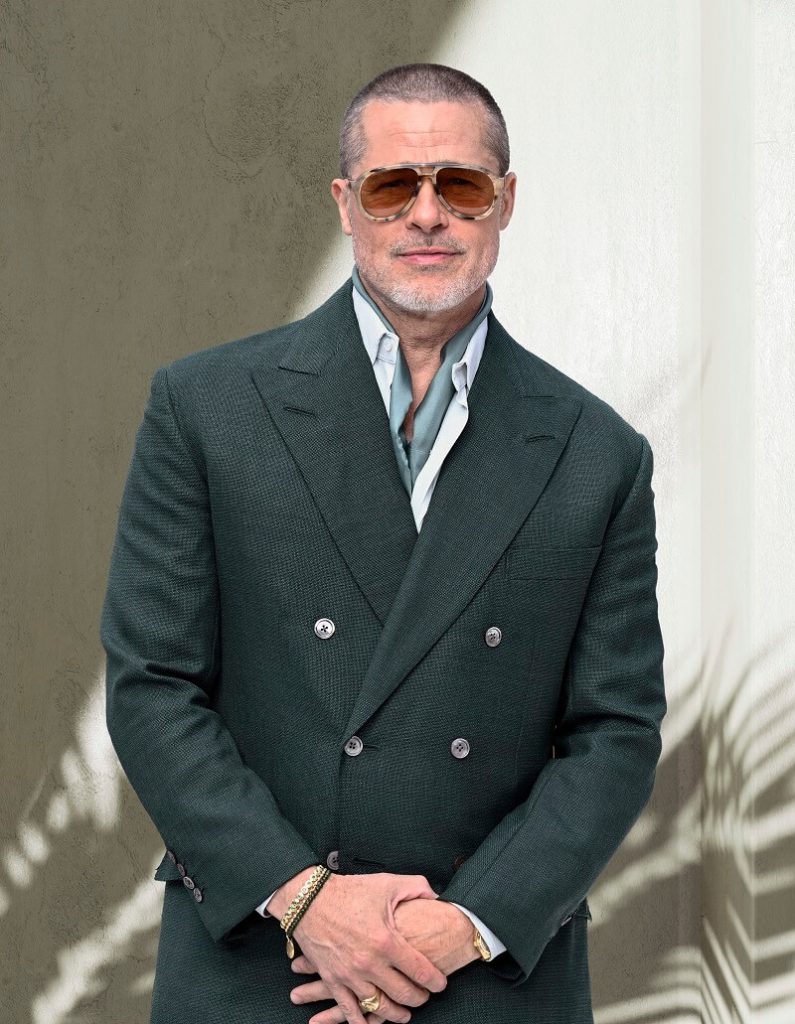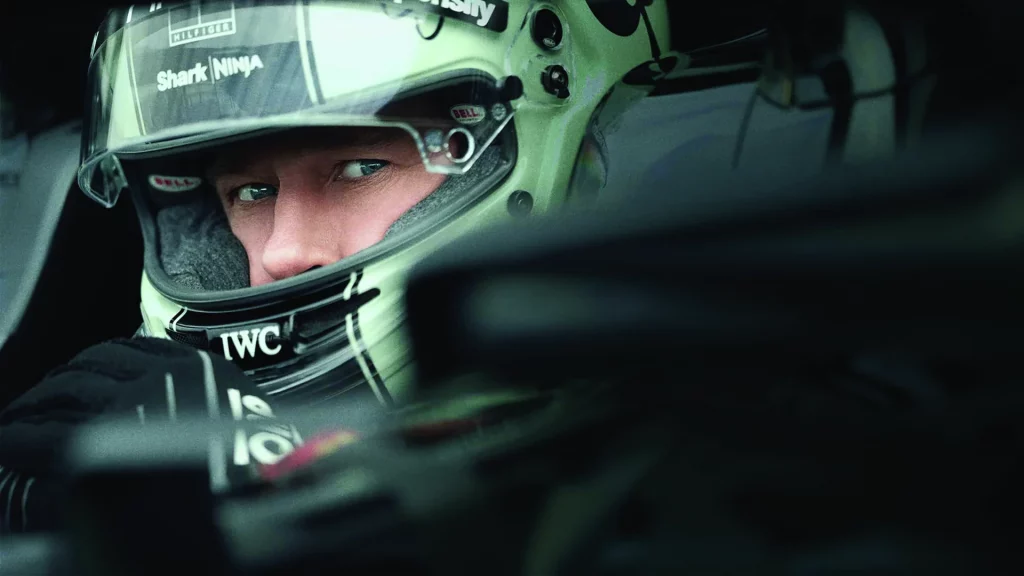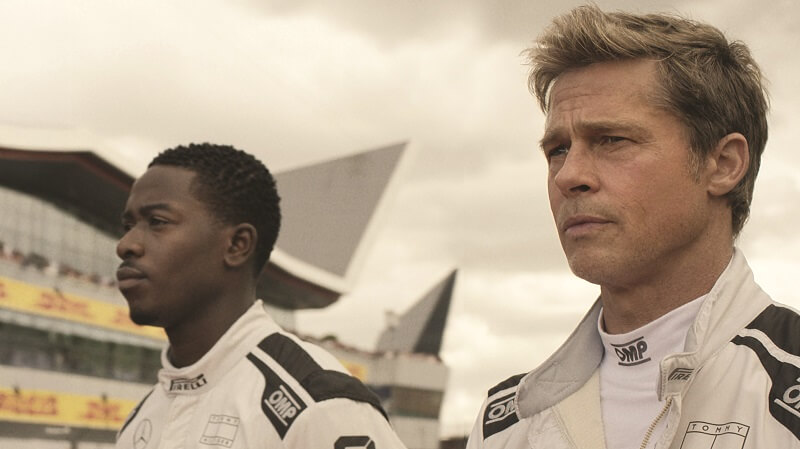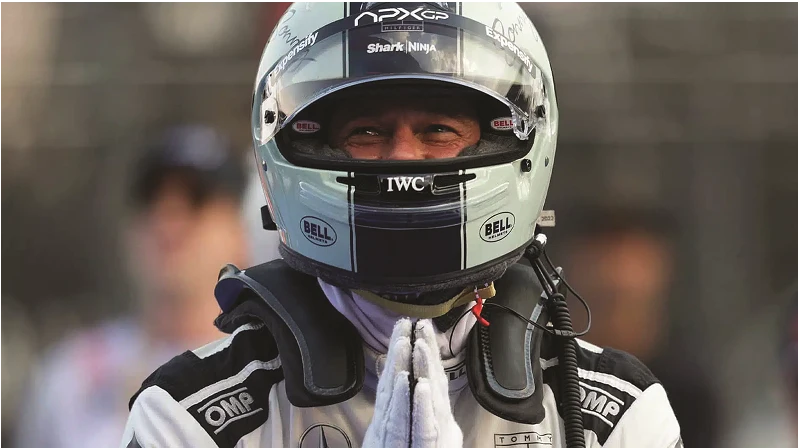Brad Pitt shows no signs of slowing down. At 61, with more than three decades of stardom behind him, he remains one of Hollywood’s most enduring figures not because he’s clung to fame, but because he’s continued to evolve with it. The Pitt of today is something altogether different from the mythic sex symbol who once vaulted into popular culture in Thelma & Louise shirtless in a cowboy hat and smiling as if he had nothing to lose. That man was raw charisma. This one is something more weathered and nuanced —a seasoned actor, an award-winning producer, and, in his latest role, an aging Formula 1 driver with something left to prove at speeds of over 200 miles per hour.
The summer blockbuster hit F1: The Movie may be the most daring production of Pitt’s career. While the plot about a retired F1 driver who returns to the track to mentor a younger talent might be familiar, the method is revolutionary. For the first time in cinematic history, actors were inserted into real Formula 1 races and filmed in motion in between actual qualifying sessions and heats, on the very same tracks used by the world’s most elite drivers. No soundstages. No CGI-laden imagery. Just one of the most famous people of all time in full race gear, piloting a car capable of reaching speeds no actor has ever attempted before on camera.
As millions across the world are discovering this summer, the thrill of watching F1: The Movie in theaters is a visceral, one-of-a-kind experience, one that demands to be seen on the biggest screen possible—the power of the racing sequences is especially engrossing in IMAX, where the track envelops the screen. The only recent film that captured this kind of old-school, must-be-seen-in-theaters, word-of-mouth attention was the $1.5 billion global smash, Top Gun: Maverick. It should come as no surprise that, like that film, F1 was co-produced by Jerry Bruckheimer and directed by Joseph Kosinski.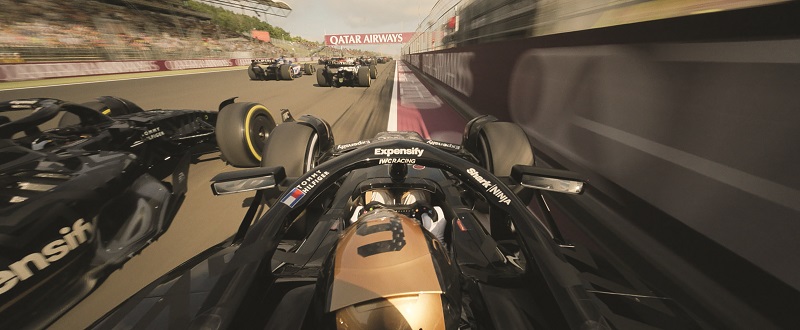
With the power of Apple Studios and F1 legend Lewis Hamilton behind them, the team was able to go where no film crew had ever gone before, capturing real action, with real actors driving on the most storied courses in the world. “It was Joe Kosinski and Jerry Bruckheimer, just coming off Maverick, who said, ‘[We]want to make the most realistic racing movie we’ve seen to date,’ and I think that’s what we’ve done,” Pitt says.
To prepare, Pitt and co-star Damson Idris, who gives a star-making performance as the young driver Pitt’s character mentors, went through a version of the real thing. Long simulator sessions, track days, and high-performance coaching prepared them for scenes that required not just technical control but absolute trust in the vehicle. Ever self-aware, Pitt had no illusions about the danger. “It’s like being strapped to a missile,” he says. But even with the preparation, it’s something you can’t fully anticipate until you’re in it. “There’s a moment,” Pitt says, “when you come out of a high-speed turn and hit the throttle, and the rear tires fight for grip, and for half a second, the whole world feels like it might spin out from under you.”
The most harrowing moments in the film are when the camera sits inches from Pitt’s helmet, capturing the real G-force tugging at his jawline, his eyes scanning the road with terrifying intensity. This is no green-screen illusion. It’s a 61-year-old man doing something very few humans have done: driving a Formula car on a live Grand Prix circuit. Once in motion, the track narrows, focus sharpens, and the scenery begins to blur. Corners don’t approach—they attack. Pitt says what surprised him most is how physical it all is: the neck strain, the rapid reflexes, the sheer force of each downshift. “You feel every inch of it,” he says. “The car becomes part of your nervous system.”
The film was shot over the course of multiple race weekends throughout 2023 and 2024, with the F1: The Movie crew given unprecedented access to the action. At the British Grand Prix, Pitt stood on the grid during the national anthem and suited up beside the likes of Max Verstappen and Hamilton. At Austin’s Circuit of the Americas, he clocked a blistering 197mph in a 2023 McLaren, drawing reactions from actual F1 drivers who weren’t sure if the new guy in the pit lane was playing a role or becoming one of them. “I was gutted I didn’t hit 200,” Pitt admits. “But I’ll take it.” These aren’t staged shots. These are real, timed laps, captured by cameras bolted to the metal, vibrating with every bump in the terrain.
The respect between Pitt and the racing community is real. Hamilton, whose presence on the film as a producer and technical advisor helped elevate the authenticity level, was impressed by Pitt’s focus and his willingness to fully engage with the culture of the sport. Other drivers have noted that Pitt didn’t just show up to film scenes; he asked questions, walked the paddock, watched telemetry screens, and treated the environment with the seriousness it demands. That credibility matters, because F1 isn’t just speed and glamour. It’s a culture of discipline and risk, of data and daring. Dropping a Hollywood production into the middle of it without disrupting the machinery is no small feat. That Pitt can navigate that space, literally and metaphorically, speaks volumes.
But F1: The Movie isn’t a one-off thrill. It’s a continuation of the trajectory Pitt has traced for years now—toward projects that require more than presence. Toward craft. Toward risk. Toward growth. His Oscar-winning role in Quentin Tarantino’s Once Upon a Time in Hollywood is a performance of quiet depth and sly humor, anchored by an actor who is not trying to impress, but to disappear. It’s also one that he will be reprising soon in a spinoff film written by Tarantino and directed by Pitt’s old Se7en and Fight Club partner, David Fincher. His producing work through Plan B, the company he co-founded in 2001, has brought some of the most beloved and acclaimed films of the last two decades, including Best Picture winners The Departed, 12 Years a Slave, and Moonlight.
Pitt’s name in the credits, whether in front of or behind the camera, has come to signal a kind of ambition—a willingness to go where others won’t. That doesn’t mean he’s turned away from spectacle. He still headlines major projects. He still leans into action. But even in those films, there’s a subtle shift. Bullet Train is stylish and kinetic, but it’s also laced with a self-deprecating wink. Babylon pushed him into extremes, but with a knowing sadness that comes from a majority of one’s life spent working the camera. There’s clarity in his choices now. Fame is no longer a destination or a detriment. It’s a lens. It’s a tool. He’s spoken openly about aging, sobriety, and fatherhood. He doesn’t dodge the difficult topics. He doesn’t feed the machine, either. He just works—carefully, selectively, and meaningfully.
And yet, that boyish glint remains. The Missouri kid who raced dirt bikes and studied journalism before heading west to follow a dream still lies somewhere behind those blue eyes. That spirit is what still animates him, still serves as his compass. He says yes to a film like F1, not because it’s safe or easy, but because it’s a new frontier. Because it puts something real on the line. He could’ve shot it in a studio. He could’ve let stunt drivers cover the heavy lifting. But he didn’t, because he’s interested in the feeling, the raw, physical truth of it. “You can’t fake this,” he says. “You either do it, or you don’t.”
In many ways, F1: The Movie is the purest expression of the two sides of Pitt’s creative life: the actor chasing immersion, and the producer chasing innovation. With a reported $200-million-plus budget, Apple Studios isn’t just betting on a blockbuster; it’s investing in a film that might redefine what a sports movie can be. Shot with cameras developed specifically for race conditions, embedded in real-world competition, and driven by a man who could easily have said no—it’s part documentary, part adrenaline opera. The fact that Pitt is in the center of it after all this time tells you everything about the kind of artist and person he’s chosen to become.
He has nothing left to prove. He’s won the awards, survived the scandals, and outlasted the news cycles. But he’s still pushing, still chasing the next feeling, the next story, the next sharp turn taken at 180mph. Whether that’s behind the wheel of a race car or in front of a camera doesn’t seem to matter. What matters is that he’s fully in it. And if you watch him now—in the suit, visor down, head forward, throttle open—you see it clearly. This isn’t performance. It’s propulsion. It’s purpose. It’s Brad Pitt, American icon, still accelerating.


